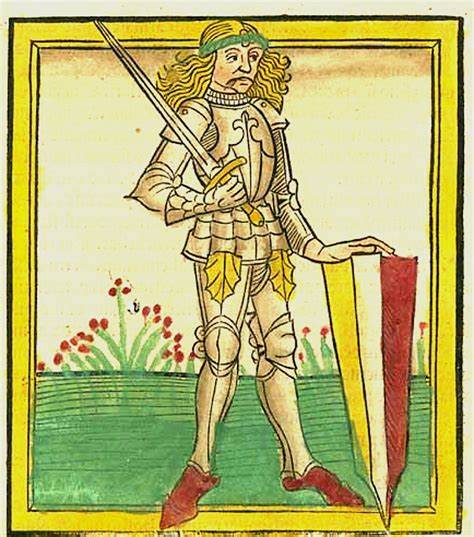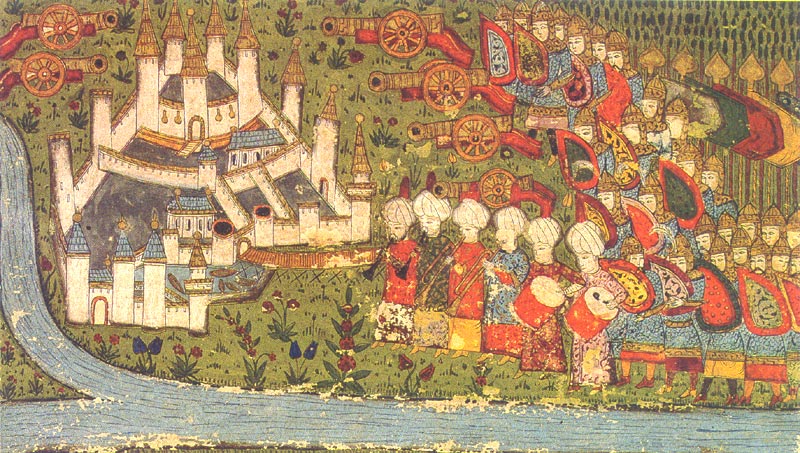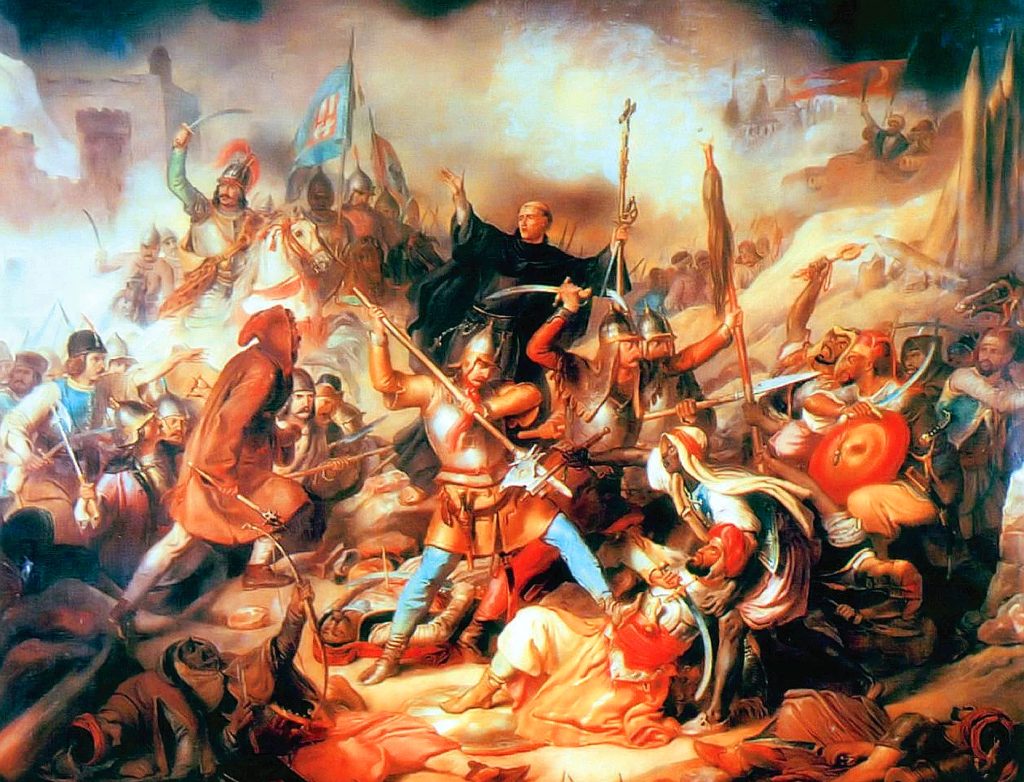
Please follow us on Gab, Minds, Telegram, Rumble, GabTV, Truth Social, Gettr
Together with the Albanian hero Scanderbeg, John Hunyadi, voivode of Transylvania and Royal Governor Hungary is considered the greatest defender of Christendom during the mid-fifteenth century. Born to a small noble family in Transylvania, Hunyadi began his career under Sigismund of Luxemburg, King of Hungary (1387-1437). Through his military prowess, he quickly advanced in rank. He distinguished himself through victories over the Ottomans in the early 1440s, particularly during the Long Campaign in 1443 in which he penetrated deep into Ottoman territory and threatened the Sultan’s capital at Adrianople. Despite the internal dynastic struggles that shook Hungary following the death of Sigismund, Hunyadi managed to organize the defense of the country against the Ottoman threat and lent hope to the peoples of the Balkans seeking liberation from the yoke of Islam.
Defeats at Varna in 1444 and at Kosovo in 1448 weakened his authority and the fall of Constantinople in 1453 left Hungary, like Albania, now exposed to the full force of Ottoman might. With no hope of significant help from the West on the horizon, John Hunyadi prepared for the inevitable attack. It came in 1456 when Mehmed launched a new offensive in the Balkans. Hunyadi gathered an army and left for Belgrade, at the junction of the Danube and the Sava rivers, where he prepared to face the mighty conqueror of Constantinople.
John Hunyadi Readies the Defense of Belgrade
While the two armies maneuvered into position, the Christian forces under Hunyadi’s command managed to push back the Ottoman fleet, which had tried to cut off the supply line to the city. Despite this setback, the Sultan was confident that his forces would prevail against the smaller Christian force. On July 21, 1456, Mehmed II ordered a general assault on the city. The Ottoman army now stirred into action.
Inside the fortress and far across the Sava, in the camp of the crusaders, throughout that entire morning, one could hear the ceaseless beat of the drums that announced the attack. Ottoman cannons ceaselessly bombarded the walls to open a breach for the infantry assault. In preparation, John Hunyadi embarked part of his army onto his ships to be able to move it more quickly and easily to the locations threatened by the Turks. He placed the other part in the immediate proximity of the fortress in support of the city’s garrison that had taken their posts along the walls. The strategic and tactical preparations of John Hunyadi in this battle appear more complex, more flexible, and, in a word, more modern than those of the sultan. He anticipated varied possibilities of attack, which would ultimately bring him victory.

The Ottoman Assault Begins
In the late afternoon of July 21, the general assault on Belgrade began. The Ottoman infantry charged across the trenches, over walls demolished by their artillery, and dispersed Christian troops that tried to oppose them, penetrating into the city. Twice the Ottomans entered the city, but each time the Christian garrison drove them back. The third time, the janissaries advanced as far as the walls of the fortress on the steep bank of the Danube, which the cannons had been unable to destroy. They tried to occupy the bridge which led into the fortress to thus prevent the retreat of the Christian troops from the city. Part of the Christian garrison, seized by fear, abandoned their weapons and tried to escape, diving into the Danube. Even in the fortress, some jumped over the walls and out the windows directly into the river, swimming toward the ships afloat around the city.
Despite the chaos, John Hunyadi remained firm in the middle of his troops, as did the crusaders, among whom women were seen fighting as well. Detachments of crusaders kept crossing the river from their camp on the Sava, coming to the aid of John of Capistrano, the papal emissary, who was defending obstinately the drawn-down bridge, across which the Ottomans could have entered the citadel. After fierce struggles, the janissaries destroyed this important objective.
In other areas, the Ottomans had thrown up ladders to take the last walls by assault. Boiling water and inflammable materials were thrown down upon them. Nevertheless, they began to climb the ladders. Near one of the cannons, on the parapet, stood a vassal of Hunyadi, one of his close allies, named Titus Dugovich. He had fought at the side of his master at Varna as well. In the section he now defended, the Ottomans had reached the height of the parapet. In front of him, a soldier carrying the flag of the Crescent prepared to place it on the wall. Titus Dugovich rushed toward him. Clenched together, the two soldiers fell off the high tower and died in the trench. The reinforcements that kept coming across the Sava allowed, toward evening, the launching of a counterattack that repelled the Ottomans completely. Belgrade was reconquered, the janissaries fled back to the cannons where they had started their assault a few hours earlier. The battle continued after dark, but Hunyadi gave orders to halt the pursuit, thus giving the troops time to rest.
A Second Day of Battle Ensues
At the break of dawn on July 22, things remained quiet. But the battle was gradually resumed. Animated by the victory of the previous day, the Christian troops could not be restrained. Without waiting for direct orders, the detachments of Christian volunteers began to harass the Turks, engaging in isolated confrontations with units of Ottoman cavalry. The battle quickly gained proportion. The entire camp of crusaders now crossed the Sava and rushed upon the armies from Anatolia. At that time, John Hunyadi was near the Christian ships. Seeing that the army could not be stopped from the struggle it had begun, he decided to intervene with his troops, scattered inside the fortress and throughout the city. A general attack broke out against the Ottoman camp. The cannons of the sultan were captured and turned against the fleeing Ottoman troops. The janissaries, however, still fought vigorously. Sultan Mehmed II, although wounded by an arrow in his calf, remained among them. The aga of the janissaries, Hassan, died protecting the sultan with his body. Mehmed repelled the troops that had penetrated into his camp and ordered that the lost cannons be recovered at any price. The Ottomans attacked three times, but the deadly fire they confronted vanquished them. The cannons remained in the hands of Hunyadi’s army. The Ottoman army showed signs of discouragement, especially after the detachment of well-rested cavalrymen failed to change the course of the battle. The Sultan and the troops around him resisted in their camp until evening. During the night of July 22 to 23, the Ottomans buried their dead, according to their custom, loaded their wounded in a long row of wagons, and evacuated the camp in a hurry, heading toward the southeast.
A Decisive Victory followed by Great Tragedy
The victory at Belgrade breathed new life into the anti-Ottoman struggle. It effectively halted the Islamic advance into Europe for the next seventy years. News of the Ottoman defeat was hailed throughout the capitals of Europe. Pope Calixtus III, the first Borgia pope, praised the Hungarian leader, declaring Hunyadi an “Athlete of Christ,” comparing him to the great commanders of antiquity.
Part of Hunyadi’s plan to defend the Danube frontier against Ottoman aggression included placing a strong anti-Ottoman ruler on the throne of the Danubian principality of Wallachia. To this end, he had helped Vlad III Dracula seize the throne of Wallachia in the summer of 1456. But just as things seemed to come together for a new Christian offensive, with the great victory at Belgrade, tragedy struck. An epidemic spread throughout the Christian camp. On August 11, 1456, the great leader of the Christian cause, who had bravely defended Transylvania and Hungary from the Ottoman peril during the previous two decades, passed away. His body was returned to his native Transylvania, where he was buried at the cathedral at Alba Iulia. The Christian cause had lost one of its fiercest defenders.
Recommended Reading
For more on the life of John Hunyadi, see John Hunyadi: Defender of Christendom by Camil Muresanu (Palm Beach: Center for Romanian Studies, 2019).
On the life of Hunyadi’s contemporary Scanderbeg, see Scanderbeg: A History of George Castriota and the Albanian Resistance to Islamic Expansion in Fifteenth Century Europe by A.K. Brackob (Las Vegas: Vita Histria, 2018).
On Vlad III Dracula, also known as Vlad the Impaler, see Dracula: Essays on the Life and Times of Vlad the Impaler (Palm Beach: Center for Romanian Studies, 2018), and Vlad III Dracula: The Life and Times of the Historical Dracula by Kurt W. Treptow (Palm Beach: Center for Romanian Studies, 2020).

John Hunyadi and the Defense of Belgrade, 1456
Together with the Albanian hero Scanderbeg, John Hunyadi, voivode of Transylvania and Royal Governor Hungary is considered the greatest defender of Christendom during the mid-fifteenth century. Born to a small noble family in Transylvania, Hunyadi began his career under Sigismund of Luxemburg, King of Hungary (1387-1437). Through his military prowess, he quickly advanced in rank. He distinguished himself through victories over the Ottomans in the early 1440s, particularly during the Long Campaign in 1443 in which he penetrated deep into Ottoman territory and threatened the Sultan’s capital at Adrianople. Despite the internal dynastic struggles that shook Hungary following the death of Sigismund, Hunyadi managed to organize the defense of the country against the Ottoman threat and lent hope to the peoples of the Balkans seeking liberation from the yoke of Islam.
Defeats at Varna in 1444 and at Kosovo in 1448 weakened his authority and the fall of Constantinople in 1453 left Hungary, like Albania, now exposed to the full force of Ottoman might. With no hope of significant help from the West on the horizon, John Hunyadi prepared for the inevitable attack. It came in 1456 when Mehmed launched a new offensive in the Balkans. Hunyadi gathered an army and left for Belgrade, at the junction of the Danube and the Sava rivers, where he prepared to face the mighty conqueror of Constantinople.
John Hunyadi Readies the Defense of Belgrade
While the two armies maneuvered into position, the Christian forces under Hunyadi’s command managed to push back the Ottoman fleet, which had tried to cut off the supply line to the city. Despite this setback, the Sultan was confident that his forces would prevail against the smaller Christian force. On July 21, 1456, Mehmed II ordered a general assault on the city. The Ottoman army now stirred into action.
Inside the fortress and far across the Sava, in the camp of the crusaders, throughout that entire morning, one could hear the ceaseless beat of the drums that announced the attack. Ottoman cannons ceaselessly bombarded the walls to open a breach for the infantry assault. In preparation, John Hunyadi embarked part of his army onto his ships to be able to move it more quickly and easily to the locations threatened by the Turks. He placed the other part in the immediate proximity of the fortress in support of the city’s garrison that had taken their posts along the walls. The strategic and tactical preparations of John Hunyadi in this battle appear more complex, more flexible, and, in a word, more modern than those of the sultan. He anticipated varied possibilities of attack, which would ultimately bring him victory.
The Ottoman Assault Begins
In the late afternoon of July 21, the general assault on Belgrade began. The Ottoman infantry charged across the trenches, over walls demolished by their artillery, and dispersed Christian troops that tried to oppose them, penetrating into the city. Twice the Ottomans entered the city, but each time the Christian garrison drove them back. The third time, the janissaries advanced as far as the walls of the fortress on the steep bank of the Danube, which the cannons had been unable to destroy. They tried to occupy the bridge which led into the fortress to thus prevent the retreat of the Christian troops from the city. Part of the Christian garrison, seized by fear, abandoned their weapons and tried to escape, diving into the Danube. Even in the fortress, some jumped over the walls and out the windows directly into the river, swimming toward the ships afloat around the city.
Despite the chaos, John Hunyadi remained firm in the middle of his troops, as did the crusaders, among whom women were seen fighting as well. Detachments of crusaders kept crossing the river from their camp on the Sava, coming to the aid of John of Capistrano, the papal emissary, who was defending obstinately the drawn-down bridge, across which the Ottomans could have entered the citadel. After fierce struggles, the janissaries destroyed this important objective.
In other areas, the Ottomans had thrown up ladders to take the last walls by assault. Boiling water and inflammable materials were thrown down upon them. Nevertheless, they began to climb the ladders. Near one of the cannons, on the parapet, stood a vassal of Hunyadi, one of his close allies, named Titus Dugovich. He had fought at the side of his master at Varna as well. In the section he now defended, the Ottomans had reached the height of the parapet. In front of him, a soldier carrying the flag of the Crescent prepared to place it on the wall. Titus Dugovich rushed toward him. Clenched together, the two soldiers fell off the high tower and died in the trench. The reinforcements that kept coming across the Sava allowed, toward evening, the launching of a counterattack that repelled the Ottomans completely. Belgrade was reconquered, the janissaries fled back to the cannons where they had started their assault a few hours earlier. The battle continued after dark, but Hunyadi gave orders to halt the pursuit, thus giving the troops time to rest.

A Second Day of Battle Ensues
At the break of dawn on July 22, things remained quiet. But the battle was gradually resumed. Animated by the victory of the previous day, the Christian troops could not be restrained. Without waiting for direct orders, the detachments of Christian volunteers began to harass the Turks, engaging in isolated confrontations with units of Ottoman cavalry. The battle quickly gained proportion. The entire camp of crusaders now crossed the Sava and rushed upon the armies from Anatolia. At that time, John Hunyadi was near the Christian ships. Seeing that the army could not be stopped from the struggle it had begun, he decided to intervene with his troops, scattered inside the fortress and throughout the city. A general attack broke out against the Ottoman camp. The cannons of the sultan were captured and turned against the fleeing Ottoman troops. The janissaries, however, still fought vigorously. Sultan Mehmed II, although wounded by an arrow in his calf, remained among them. The aga of the janissaries, Hassan, died protecting the sultan with his body. Mehmed repelled the troops that had penetrated into his camp and ordered that the lost cannons be recovered at any price. The Ottomans attacked three times, but the deadly fire they confronted vanquished them. The cannons remained in the hands of Hunyadi’s army. The Ottoman army showed signs of discouragement, especially after the detachment of well-rested cavalrymen failed to change the course of the battle. The Sultan and the troops around him resisted in their camp until evening. During the night of July 22 to 23, the Ottomans buried their dead, according to their custom, loaded their wounded in a long row of wagons, and evacuated the camp in a hurry, heading toward the southeast.
A Decisive Victory followed by Great Tragedy
The victory at Belgrade breathed new life into the anti-Ottoman struggle. It effectively halted the Islamic advance into Europe for the next seventy years. News of the Ottoman defeat was hailed throughout the capitals of Europe. Pope Calixtus III, the first Borgia pope, praised the Hungarian leader, declaring Hunyadi an “Athlete of Christ,” comparing him to the great commanders of antiquity.
Part of Hunyadi’s plan to defend the Danube frontier against Ottoman aggression included placing a strong anti-Ottoman ruler on the throne of the Danubian principality of Wallachia. To this end, he had helped Vlad III Dracula seize the throne of Wallachia in the summer of 1456. But just as things seemed to come together for a new Christian offensive, with the great victory at Belgrade, tragedy struck. An epidemic spread throughout the Christian camp. On August 11, 1456, the great leader of the Christian cause, who had bravely defended Transylvania and Hungary from the Ottoman peril during the previous two decades, passed away. His body was returned to his native Transylvania, where he was buried at the cathedral at Alba Iulia. The Christian cause had lost one of its fiercest defenders.
Recommended Reading
For more on the life of John Hunyadi, see John Hunyadi: Defender of Christendom by Camil Muresanu (Palm Beach: Center for Romanian Studies, 2019).
On the life of Hunyadi’s contemporary Scanderbeg, see Scanderbeg: A History of George Castriota and the Albanian Resistance to Islamic Expansion in Fifteenth Century Europe by A.K. Brackob (Las Vegas: Vita Histria, 2018).
On Vlad III Dracula, also known as Vlad the Impaler, see Dracula: Essays on the Life and Times of Vlad the Impaler (Palm Beach: Center for Romanian Studies, 2018), and Vlad III Dracula: The Life and Times of the Historical Dracula by Kurt W. Treptow (Palm Beach: Center for Romanian Studies, 2020).
Dr. Kurt Brackob has a Ph.D. in history and is a noted specialist on Southeast European history. He is currently the Director of Histria Books, a leading independent publishing house with offices in Las Vegas and Palm Beach, which publishes trade fiction and non-fiction, children’s books, and academic titles across its seven imprints. In addition to a career in publishing, he has a background in banking and finance, as well as academics.